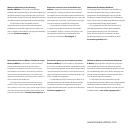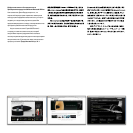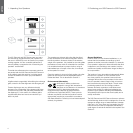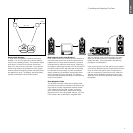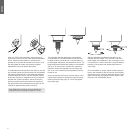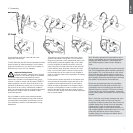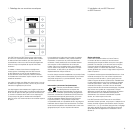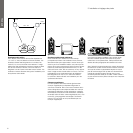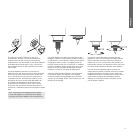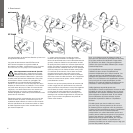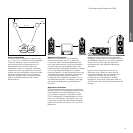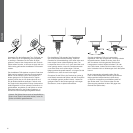
7
ENGLISH
All connections should be made with the audio
equipment switched off.
The 800 Diamond and 802 Diamond speaker terminals
accept a variety of cable terminations: 4mm banana
plugs, 6mm and 8mm (1/4 in and 5/16 in) spades, or
bare wires up to 4mm (5/32 in) diameter.
Important Safety Notice
In certain countries, notably those in Europe,
the use of 4mm banana plugs is considered
a potential safety hazard, because they may be
inserted into the holes of unshuttered mains supply
sockets. In order to comply with European CENELEC
safety regulations, the 4mm holes in the ends of the
terminals are blocked by plastic pins. If you are using
the products in any country where these conditions
apply, you should ensure that any banana plugs cannot
be used in an unsafe manner by children or other
uninformed persons.
Ask your dealer for advice when selecting speaker
cable. Keep its total impedance below the maximum
recommended in the speaker specication and use
a low inductance cable to avoid attenuation of high
frequencies.
4. Connecting
There are two pairs of terminals at the back of each
speaker that enable bi-wiring (left). For conventional,
single wire connection, t the supplied link wires to join
the like polarity terminals together (right). If the cable
from the amplier has spade connectors, t the link
wires using the 4mm hole at the end of each terminal.
If it has banana plugs, t the link wires into the cross
holes. You may also need to remove the caps of the
two terminals used for the cable from the amplier in
order to maximise contact area, especially if its banana
plugs are short.
Ensure that the positive terminals on the speaker (red)
are connected to the positive output terminal on the
amplier and the negative terminals on the speaker
(black) are always connected to the negative output
terminal on the amplier. Incorrect connection will not
result in damage but will cause poor stereo imaging
and loss of bass. Always screw the terminal caps down
fully to prevent rattles.
Note: Bi-wiring separates the signal paths to each
section of the speaker and can improve both stereo
imaging and detail resolution. It also enables the
use of different types of cable for each frequency
band.
Bi-amplification goes a stage further and involves the
use of two independent power amplifier channels for
each speaker. This is not the same as a fully “active”
drive as the speaker's internal passive crossover is
still used. If bi-amplification is employed, ensure that
each amplifier channel has the same gain, otherwise
the speaker’s tonal balance will be distorted.
Check also the absolute polarity of the amplifiers.
Some amplifiers invert the signal, and their use in
combination with non-inverting types will result in a
distorted frequency response. If you have a mixture
of inverting and non-inverting amplifiers, reverse the
polarity of the speaker connections from the inverting
amplifier.
Bear in mind that, even though midrange and, even
more so, tweeter drivers can (and only need to)
handle less continuous power than bass drivers, the
amplifier feeding them needs to have an adequate
voltage swing in order to supply the short-term
high-frequency peaks in music without distortion. A
high voltage capability implies high power, so it is not
particularly desirable to have a lower powered
amplifier feeding the midrange and tweeter than is
used for bass drivers.




